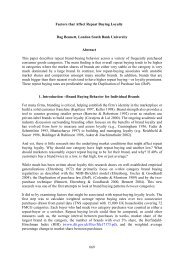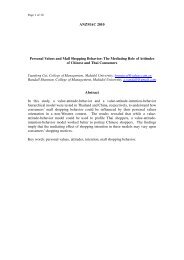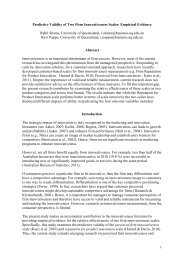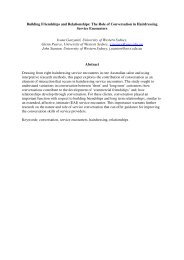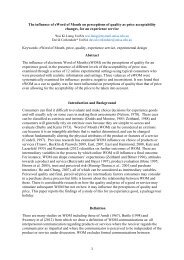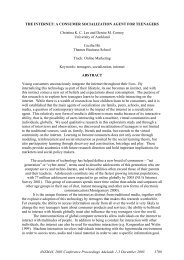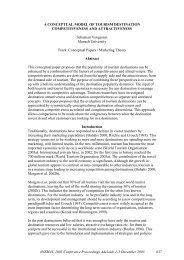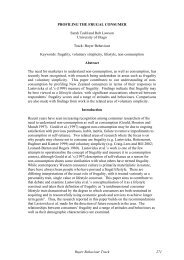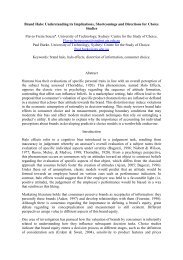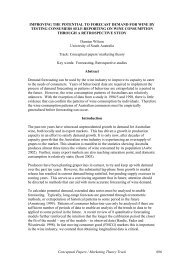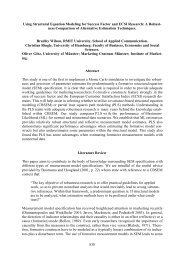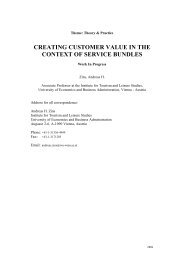amj Australasian Marketing Journal - ANZMAC
amj Australasian Marketing Journal - ANZMAC
amj Australasian Marketing Journal - ANZMAC
Create successful ePaper yourself
Turn your PDF publications into a flip-book with our unique Google optimized e-Paper software.
Country Design and Assembly<br />
ple that consumers preferred the domestic country (Australia)<br />
as the best COA . Furthermore in the other cases studied,<br />
Japan and the U.S. are perceived as the best COA and COD<br />
for cars and jeans respectively. Therefore, this result does not<br />
support the proposition that consumers always prefer domestic<br />
products as argued by some researchers. The home-country<br />
bias is not inevitable for all products; rather it is product<br />
specific. An alternative explanation for not selecting other<br />
domestic products might be the present situation or stage of<br />
market development. According to Papadopoulos and Heslop<br />
(1993: 45) Domestic preference will be lower where the<br />
market is filled with the products of foreign manufacturers<br />
(i.e., open economies), especially if these manufacturers<br />
provide good market support and after-sale services . Such a<br />
situation clearly applies in Australia. Furthermore, the widely<br />
held stereotype of Japan and the U.S. as producers of high<br />
quality cars and jeans generally overpowers any nationalistic<br />
pre-dispositions.<br />
6. Conclusions and Implications<br />
The above analysis presents the importance of the four attributes<br />
of COA, COD, brand and price in purchase intentions<br />
and quality evaluations. The most striking conclusion is that<br />
COA appears to be most important attribute in the choice for<br />
all the products studied; even when this information is given<br />
with other information of brand name and price. This has<br />
major policy implications for companies which are contemplating<br />
shifting their assembly or production location to a<br />
lower cost, less developed country. Clearly, the impact of the<br />
possible negative COA effects must be anticipated when<br />
making such a policy decision. For a high involvement product,<br />
such as cars, this effect even overpowers the brand image<br />
of a product. COD, on the other hand, though significant, is<br />
not strong for all three products quality evaluations and<br />
purchase intentions. A negative COD could be overcome by a<br />
well-known brand and/or lower price and, above all, a<br />
preferred COA. This result also shows that in a multi-cue<br />
conjoint experiment, the country effect, especially COA, is<br />
still higher than other cues.<br />
This study has investigated three major issues: (1) it investigated<br />
the effects of COA and COD on judgement of quality and<br />
purchase intentions; (2) it explored whether there is any home<br />
country bias among consumers in Australia; and (3) it examined<br />
whether presence of information about brand names and<br />
price would overpower COA and COD in consumers evaluations<br />
of product quality and purchase intention.<br />
While COA is clearly the most important attribute, the effect<br />
of COD is also significant but the effect is secondary. The<br />
intensity of the effect of COD was found to vary with the<br />
product categories. The significant interaction between COA<br />
and COD implies that a product designed in a developed<br />
country and assembled in a less developed country could<br />
partially counterbalance the negative image associated with<br />
70 <strong>Australasian</strong> <strong>Marketing</strong> <strong>Journal</strong> 9 (1), 2001<br />
the less developed country. However the COA is still the most<br />
important consideration.<br />
This study did not find any form of home country bias for<br />
high and medium involvement products. Home country bias<br />
was found only in the case of tinned pineapples assembled<br />
and designed in Australia. The home country preference for<br />
pineapple could be because of the perception of freshness,<br />
hygiene and safety associated with the Australian food industry.<br />
In the other cases, Japan, in the case of cars, and the U.S.,<br />
in case of jeans, are perceived as the best COA and COD. This<br />
result therefore refutes the proposition that consumers always<br />
prefer the domestic product. The home-country bias is not<br />
inevitable for all products; rather it is product-specific.<br />
It was also found in this study that a country hierarchy exists<br />
in the minds of Australian consumers. Three countries were<br />
chosen according to their level of economic development.<br />
Australia was chosen to examine the domestic country bias,<br />
Japan (the U.S. in case of jeans) as a highly developed country<br />
and South Korea (the Philippines in the case of tinned<br />
pineapple) as less developed than Australia. The result clearly<br />
indicates that, though the construct of COO has been<br />
partitioned into COA and COD , still most of the respondents<br />
ranked a developed country (here, Japan and the U.S.)<br />
as the best COA and COD. Therefore, as previously suggested<br />
by many researchers (Wall, Liefeld and Heslop, 1989,<br />
1991; Schellinck, 1989a, 1989b) this study has confirmed a<br />
positive relationship between product evaluations and the<br />
degree of economic development of the source country in a<br />
multi-cue conjoint setting.<br />
The findings of the current research showed that the effect of<br />
brand appears to be product specific and it is not as important<br />
as COA. In the case of medium and low involvement products<br />
(jeans and tinned pineapple) the brand is the second most<br />
important factor. That is, in case of making purchase decisions<br />
consumers appear to consider information concerning<br />
which country the product is assembled in and, then, the<br />
brand (Table 5). For cars, brand is least in importance suggesting<br />
that, for such a high priced product, consumers may be<br />
prepared to trade off brand for other attributes, especially<br />
price. This may also suggest that consumers also regard the<br />
cars of all the brands and countries as broadly acceptable and,<br />
that being the case, they will make their choices based on<br />
other attributes. In case of quality evaluations, brand is placed<br />
as second most important factor (Table 3) for jeans and<br />
pineapple, but least important factor for cars.<br />
This study has also demonstrated that the price—choice relation<br />
is product specific. For a high involvement product, like<br />
cars, price is the second most important factor in influencing<br />
choice and third most important in evaluation of quality. This<br />
may reflect the absolute price differences studied and the fact<br />
that the cars studied were well known to respondents. Clearly,<br />
the issue involvement and attendant risk is a key contingent<br />
factor here; as the effect of a mistake in a car purchase is



